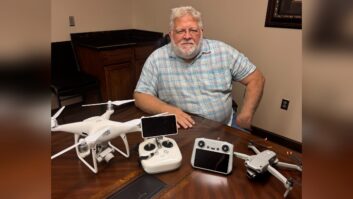Great summertime weather means it’s time to follow through with the ground-rod projects we talked about in the March 30 issue. Since then, my mailbox has been filled with solutions to sinking a 10-foot ground rod successfully.
It seems everyone has been down the “step ladder and sledge hammer” road!
Here are some other worthwhile suggestions.
Both Paul Kaminski at Motor Sports Radio and Dave Cass from WJDF(FM) in Orange, Mass., suggested my old favorite, the W. W. Grainger catalog, for solving your problem.
Dave pointed out that Grainger sells several bits identified as ground rod drivers. The SDS shanks may or may not fit jackhammers, but the 1-1/8-inch hex shank will. As for using a jackhammer for this job, Dave admits he’s no expert, but suggests that the hammer be throttled way back, to drive the rod rather than bend it.
Fairmont Tools, on the Web at www.fairmont.textron.com, makes a hydraulic post and ground rod driver. These work more or less like a jackhammer, but slower. Keep in mind that this tool requires a hydraulic power source, whereas the jackhammer needs compressed air.
. . .
Paul Kaminski referenced the same pages in the Grainger catalog, and suggests every engineer add a copy of their catalog to their reference library. The catalog includes HVAC, plumbing, electrical, safety and security items useful for today’s chief to handle all the problems inherent to running radio stations.
Paul got his indoctrination to Grainger when they sponsored a race car on NASCAR’s Busch series, and Paul covered the media function!
Jon Banks, a contract engineer in Colorado, once hired a contractor friend to drive ground rods. He used an electric “chipping hammer,” which came with a cup shaped attachment, in addition to the chisel point. It’s been Jon’s experience that these tools generally are available at rental shops. In Jon’s case, the contractor drove eight 8-foot rods in less than half an hour.
Tom Oaklund of KPBS(FM) has seen electricians use rotary hammers, such as the Makita HR4000C or HR5000. These are 1-9/16-inch and 2-inch-capacity tools that can be set to hammer or hammer-and-rotate.
To drive the rods, the tool is set for hammer only, and the rod positioned loosely inside the chuck. Two guys then hang from the tool handles, one on each side, to provide the weight to sink the rod. San Diego is home to some pretty rocky soil, but the method worked well to sink two 10-foot ground rods.
Speaking of PBS, Bob Johnson of NASC in Poughkeepsie, N.Y., suggests contacting the PBS feature “This Old House” (www.pbs.org). On one show, they demonstrated the installation of lightning protection on a house. The contractor was shown driving the ground rod into the soil, next to the service meter, using a hammer drill and a stepladder. It appeared to Bob that they didn’t use a bit, rather they just opened the chuck of the drill enough to accept the end of the ground rod.
Using a chuck to drive the rod brings up a good point from Dave Remund, VP of Engineering for Regent Communications. Dave has a friend who runs an equipment rental yard, and recently they talked about driving ground rods with a jackhammer. He confirmed that contractors don’t use a special bit, though one is available.
However, Dave points out the advantage to the bit: the ground rod driver bit is formed into a conical cup, similar to the bit Jon Banks described. Its purpose is to stop the end of the ground rod tip from flaring out as it is driven.
If you just use the hammer or the chuck of a hammer drill, you must stop and remove the hammer from the rod periodically to check for flaring. If the flaring goes too far, it will be difficult to remove the hammer from the rod. Dave’s rental equipment friend has gotten pretty adept to removing the 3- to 4-inch pieces of ground rod that protrude from the hammer when they are returned.
. . .
(click thumbnail)Fig. 1: A paper towel holder could do this job.
What’s a paper towel holder to do? Hold wire, of course.
Figure 1 shows a typical small-reel holder; however, a similar paper towel holder is about one-tenth the price. The center rod can be removed easily to add or remove wire spools.
The holder keeps your project wire reels organized and easily accessible. Add this to the toilet paper holder that holds a roll of your favorite solder.
Next thing you know, someone will come up with a modification to a bagel slicer to facilitate cutting coax! I know, I know, you don’t need any more ideas!

. . .
Peter Burk of the remote control company that bears his name weighs in on the recent static mat discussion.
Peter writes that while an aluminum plate is an effective solution, it should be grounded through a high resistance, to prevent an arc if someone steps on it with a charge, and for electrical safety. Anything from 100k to 1 meg is appropriate.
A more convenient solution is the mats made by ESD Systems. Their type P 0.125 material is conductive, and wears well under a chair.
(click thumbnail)Fig. 2: The output insulator on this coupling network burned to the case, and eventually self-extinguished
In a control room, where personnel are not normally grounded through personal protective devices like wrist straps or heel straps, preventing static build-up is even more important than the dissipation or conductions. ESD Systems has a Sta-Proof Carpet Protector, which can be applied effectively for this purpose. Unlike spraying diluted fabric softener, this product lasts about nine months under normal use. For details, contact www.esdsystems.com.

. . .
Keeping a close eye on your AM towers will pay off. Inspect the base of each tower at least monthly.
Figure 2 demonstrates how the inspection will pay off: the output insulator on this coupling network burned to the case, and eventually self-extinguished. The carbon trace ensured there would be future problems, however – on the weekend, or in the middle of drive time, of course.
Submissions for this column are encouraged, and qualify for SBE recertification credit. Fax your submission to (703) 323-8044, or send e-mail to [email protected]







